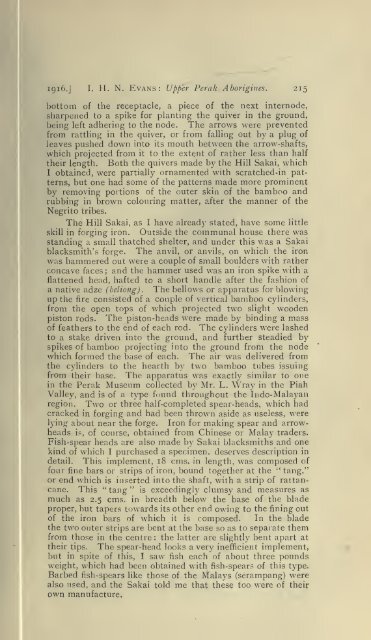Journal of the Federated Malay States museums - Sabrizain.org
Journal of the Federated Malay States museums - Sabrizain.org
Journal of the Federated Malay States museums - Sabrizain.org
You also want an ePaper? Increase the reach of your titles
YUMPU automatically turns print PDFs into web optimized ePapers that Google loves.
1916.J I. H. N. Evans: Upper Perak Aborigines, 215<br />
bottom <strong>of</strong> <strong>the</strong> receptacle, a piece <strong>of</strong> <strong>the</strong> next internode,<br />
sharpened to a spike for planting <strong>the</strong> quiver in <strong>the</strong> ground,<br />
being left adhering to <strong>the</strong> node. The arrows were prevented<br />
from rattling in <strong>the</strong> quiver, or from falling out by a plug <strong>of</strong><br />
leaves pushed down into its mouth between <strong>the</strong> arrow-shafts,<br />
which projected from it to <strong>the</strong> extent <strong>of</strong> ra<strong>the</strong>r less than half<br />
<strong>the</strong>ir length. Both <strong>the</strong> quivers made by <strong>the</strong> Hill Sakai, which<br />
I obtained, were partially ornamented with scratched-in patterns,<br />
but one had some <strong>of</strong> <strong>the</strong> patterns made more prominent<br />
by removing poitions <strong>of</strong> <strong>the</strong> outer skin <strong>of</strong> <strong>the</strong> bamboo and<br />
rubbing in brown colouring matter, after <strong>the</strong> manner <strong>of</strong> <strong>the</strong><br />
Negrito tribes.<br />
The Hill Sakai, as I have already stated, have some little<br />
skill in f<strong>org</strong>ing iron. Outside <strong>the</strong> communal house <strong>the</strong>re was<br />
standing a small thatched shelter, and under this was a Sakai<br />
blacksmith's f<strong>org</strong>e. The anvil, or anvils, on which <strong>the</strong> iron<br />
was hammered out were a couple <strong>of</strong> small boulders with ra<strong>the</strong>r<br />
concave faces; and <strong>the</strong> hammer used was an iron spike with a<br />
flattened head, hafted to a short handle after <strong>the</strong> fashion <strong>of</strong><br />
a native adze (beliong). The bellows or apparatus for blowing<br />
up <strong>the</strong> fire consisted <strong>of</strong> a couple <strong>of</strong> vertical bamboo cylinders,<br />
from <strong>the</strong> open tops <strong>of</strong> which projected two slight wooden<br />
piston rods. The piston-heads were made by binding a mass<br />
<strong>of</strong> fea<strong>the</strong>rs to <strong>the</strong> end <strong>of</strong> each rod. The cylinders were lashed<br />
to a stake driven into <strong>the</strong> ground, and fur<strong>the</strong>r steadied by<br />
spikes <strong>of</strong> bamboo projecting into <strong>the</strong> ground from <strong>the</strong> node<br />
which formed <strong>the</strong> base <strong>of</strong> each. The air was delivered from<br />
<strong>the</strong> cylinders to <strong>the</strong> hearth by two bamboo tubes issuing<br />
from <strong>the</strong>ir base. The apparatus was exactly similar to one<br />
in <strong>the</strong> Perak Museum collected by Mr. L. Wray in <strong>the</strong> Piah<br />
Valley, and is <strong>of</strong> a type found throughout <strong>the</strong> Indo-<strong>Malay</strong>an<br />
region. Two or three half-completed spear-heads, which had<br />
cracked in f<strong>org</strong>ing and had been thrown aside as useless, were<br />
lying about near <strong>the</strong> f<strong>org</strong>e. Iron for making spear and arrowheads<br />
is, <strong>of</strong> course, obtained from Chinese or <strong>Malay</strong> traders.<br />
Fish-spear heads are also made by Sakai blacksmiths and one<br />
kind <strong>of</strong> which I purchased a specimen, deserves description in<br />
detail. This implement, 18 cms. in length, was composed <strong>of</strong><br />
four fine bars or strips <strong>of</strong> iron, bound toge<strong>the</strong>r at <strong>the</strong> " tang,"<br />
or end which is inserted into <strong>the</strong> shaft, with a strip <strong>of</strong> rattancane.<br />
This "tang" is exceedingly clumsy and measures as<br />
much as 2.5 cms. in breadth below <strong>the</strong> base <strong>of</strong> <strong>the</strong> blade<br />
proper, but tapers towards its o<strong>the</strong>r end owing to <strong>the</strong> fining out<br />
<strong>of</strong> <strong>the</strong> iron bars <strong>of</strong> which it is composed. In <strong>the</strong> blade<br />
<strong>the</strong> two outer strips are bent at <strong>the</strong> base so as to separate <strong>the</strong>m<br />
from those in <strong>the</strong> centre : <strong>the</strong> latter are slightly bent apart at<br />
<strong>the</strong>ir tips. The spear-head looks a very inefficient implement,<br />
but in spite <strong>of</strong> this, I saw fish each <strong>of</strong> about three pounds<br />
weight, which had been obtained with fish-spears <strong>of</strong> this type.<br />
Barbed fish-spears like those <strong>of</strong> <strong>the</strong> <strong>Malay</strong>s (serampang) were<br />
also used, and <strong>the</strong> Sakai told me that <strong>the</strong>se too were <strong>of</strong> <strong>the</strong>ir<br />
own manufacture.

















